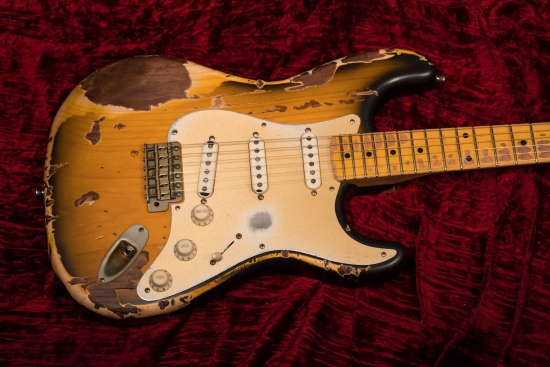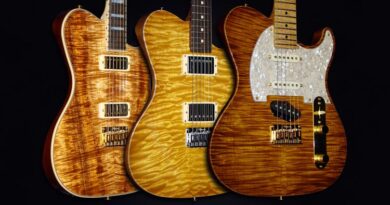Q&A: Bill Nash of Nash Guitars
Bill Nash interview by Professor Guitarism
Hi Bill. Now, lets begin with your very first beginnings. Whats the story behind Nash Guitars?
I started playing guitar at 10 years old and by the time I was 16 I was building, refinishing, customizing and sometimes ruining my own guitars 🙂 By my mid 20s I was married with kids and went to work in the business world, but after many years and getting burned out on that, my wife encouraged me to pursue something I love. I got back into the guitar business. Starting with just a few custom guitars in 2001, the business just kept growing every month.
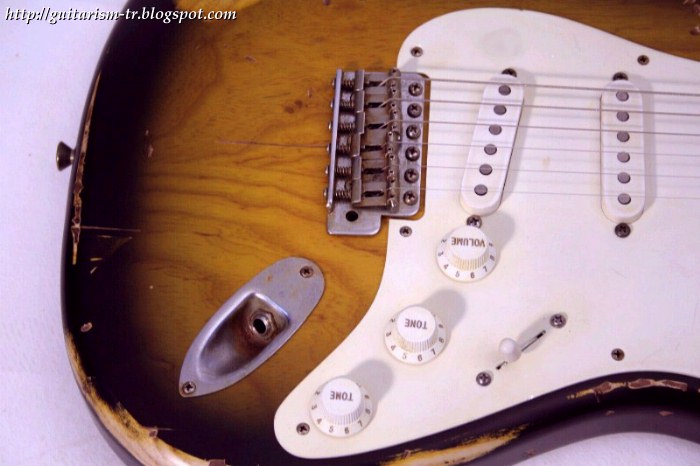

Can you please tell me the summary of the production of Nash Guitars?
I started on weekends in my basement and started selling on ebay. Things grew very fast once I started building aged guitars. We now employ 9 people and are producing about 90 guitars per month.



How many suppliers do you have for your bodies, necks with maple or rosewood?
We use 2-3 different suppliers for bodies and necks and they are all in USA.
Can you please tell me about the raw materials of your guitars? What kind of woods, what origins do they have etc.? Are your body and neck woods hand chosen by experts as in the era of Leo Fender?
Necks are maple and maple with rosewood fingerboards. All necks are a 10 inch radius and have 6105 size frets (Professor’s Note: Those are my favorite size of frets. Narrow and tall…). The bodies are mostly alder and ash and we do not use any bodies above 4.5 lbs (~2 kg). The neck come in a medium C or a Large V shape. We do vary form the original Leo Fender specs on the necks as they used a 7.25 radius and smaller frets.
Bodies are swamp ash or alder depending on the year and are in 1, 2 or in some cases, 3 piece construction. 3 pieces are rare but but in some cases three light and resonant pieces of wood will make a much better guitar. Bodies go through triage before production to keep within our weight and resonance specs. Heavy, ugly and clunky wood is rejected. We don’t use any body over 4.5lbs (~2kg).


How about finishing process of your products? I know they are all nitrocellulose lacquered. Then, why do you specifically prefer nitro finishes? Because of the original pre-CBS Fender products had nitro or technical ability about drying?
Yes, all nitrocellulose lacquer is used, including the undercoats. Nitro based, organic grain fillers are also used. We shoot as little as we can to keep the bodies as resonant as possible. We mix the colors in house and do all our own spraying.

How about Nash-ed Les Pauls?
Well, There are a few models that make good candidates for this, depending on the final color (plain, flame or gold top). The faded standards, the classic standards and classic plus standards are all possibilities.
First thing we do is to completely disassemble and separate the parts that will be aged and re-used, from the parts that we reject and replace. The “keeper” parts are then aged. The finish, which is sometimes rather thick, is stripped off down to the bare wood. At this point some get stains applied, if required to get the desired color. Then the guitar gets re-finished in 100% nitrocellulose lacquer, keeping it as thin as possible to enable superior resonance. We do a variety of takes on the lemon, cherry, faded, un-burst, plain and gold top looks.
After curing, the guitar gets the complete aging treatment and is then frets are re-worked and dressed to our specs, then we are ready for re-assembly.
The pickups are replaced with what many of you may balk at as there are so many opinions about Les Paul pickups and tone out there. As always, I simply build a guitar that I would use and leave it at that. So, in my arsenal of personal guitars, my favorite and most versatile LP setup is using a DiMarzio Bluesbucker in the Neck and a DiMarzio Air Norton in the Bridge. We re-wire the guitar so the pickups breathe better as well as use the neck pickup’s tone control as a coil tap for the Bluesbucker, which gives you an amazing strat-like sound from that pickup. Between 1 and 8 on the tone knob it works as a regular tone control, between 9 and 10 it shuts off the second/dummy coil. This gives you a tap without adding switches of push pull pots.
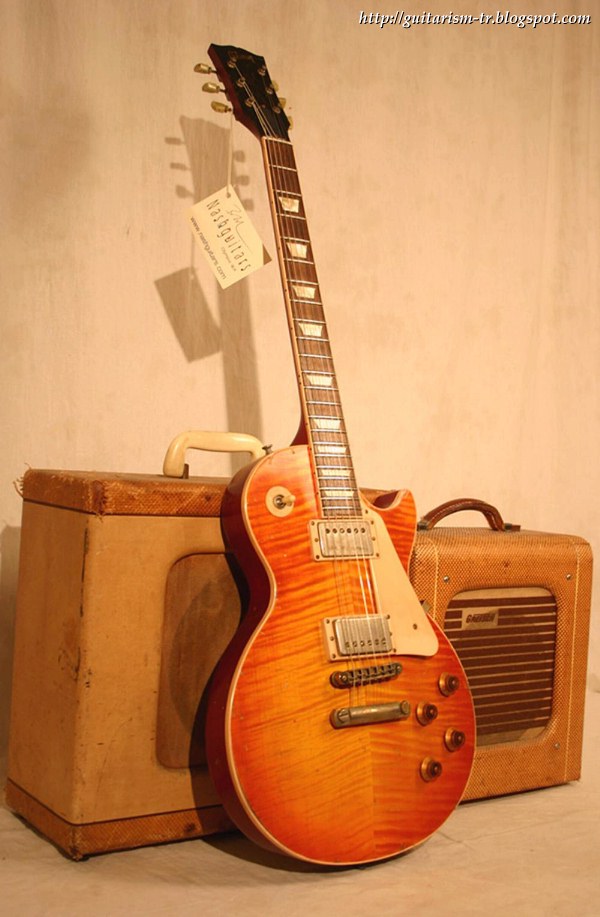
Whats wrong with stock Les Pauls?
My problem with stock Les Pauls is that the pickups never seem truly matched to each other or the position that they inhabit. The neck pickup will sound to fat and lack clarity and character. The bridge will often sound harsh or weak. The middle position (both pickups together) has an incredible potential for sparkle and quack, but no stock Les Paul, I have had, other than an actual ‘59 burst had this. I always looked for a paul that could actually use the neck pickup for rhythm, but if I set my amps for that, then the bridge pickup sounded harsh and weak. If setting the amp for a smooth, but well driven sound from the bridge, then your neck pickup is overly thick and un-clear.
Also, as many of you may have figured out, the method Gibson uses for wiring the pots is not optimum. The tendency towards the guitar getting muddy or sounding choked when anywhere but “10“. This gets re-worked when we re-wire.

Gibson installs frets on the fretboard prior to it getting glued to the neck and body. Maybe they do it as it is easier to do it that way, but it can really lead to all sort of fret issues (buzzing, fret outs, high action, dead spots etc). What happens is the neck and body glue, moisture, and all of the underlying structure will shrink, expand and or settle. The fretboard (and frets) will now adjust itself to the changes and you and up with “lumpy gravy”. The most noticeable and common issue is the hump at about the 14th fret, right where the neck gets really thick before it hit’s the body. So what we do is now re-work the neck and frets and take care of this to give the player better action, playability, sustain, bending etc.
Your products have very elegant shine of aged guitars. They are so realistic and seem like they have their own stories. Whats your point, concept on aged guitar theme?
I have studied many books on vintage guitars and try and make these aged guitars look as realistic as possible. The hand mixed nitro paint also helps as the colors have a very vintage look. It is important to really be familiar with how things age over time.
Who is making the aging job? Is it you?
My son Britton and I do all the aging.
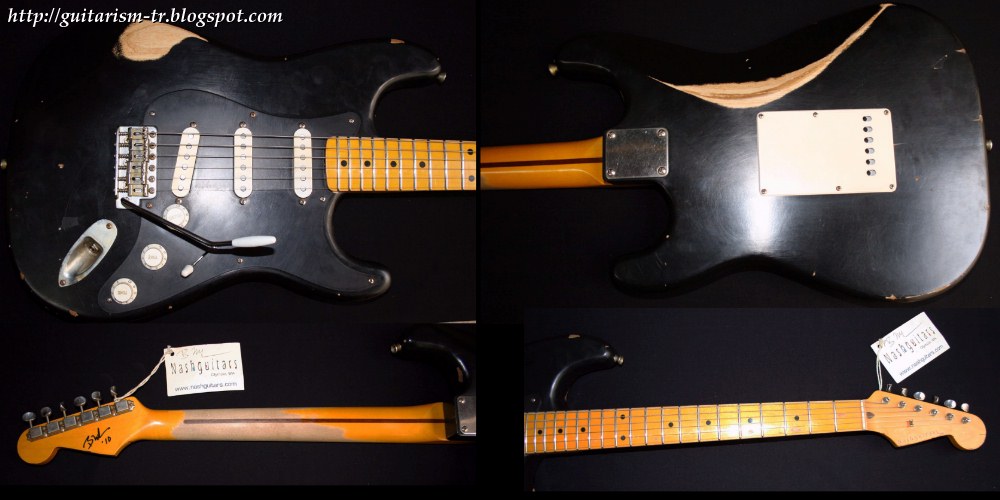
Can you please give some details about pickups of your guitars? Are they historically accurate pickup clones (you know, the singles with staggered pole pieces) or more modern ones for todays needs?
Most guitars come with custom made Lollar pickups. These are all flat pole designs. The neck (and middle) pickups are generally a very vintage sound, but we use a higher output and warmer sounding bridge model. Most guitars have too strong a neck pickup and too weak a bridge pickup. The strings have so much less vibration near the bridge and thus less energy transferred to the pickup.
What brands of machine heads, truss rods, pots and caps, nuts, frets and jacks do you prefer for your fine instruments, especially for your 50s S&T and 60s style S&T guitars?
Most parts are vintage style Gotoh or similar brand. These are the old style parts that sound great and look really correct when aged. CTS pots, CRL switches, Switchcraft jacks and Sprague Orange-drop caps are also used.
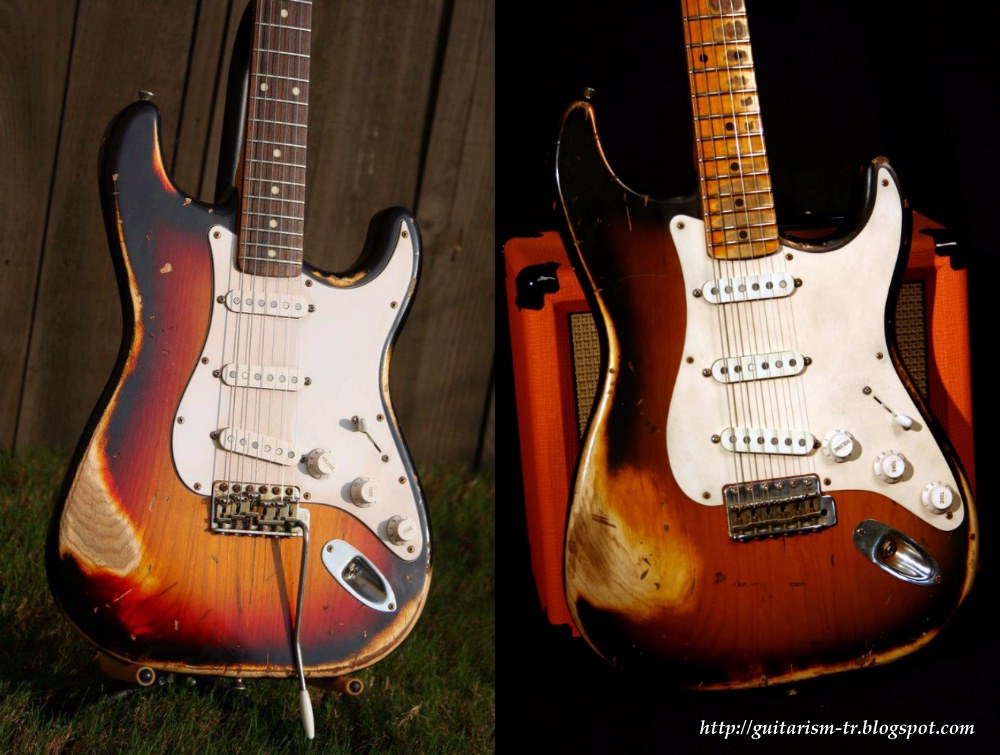
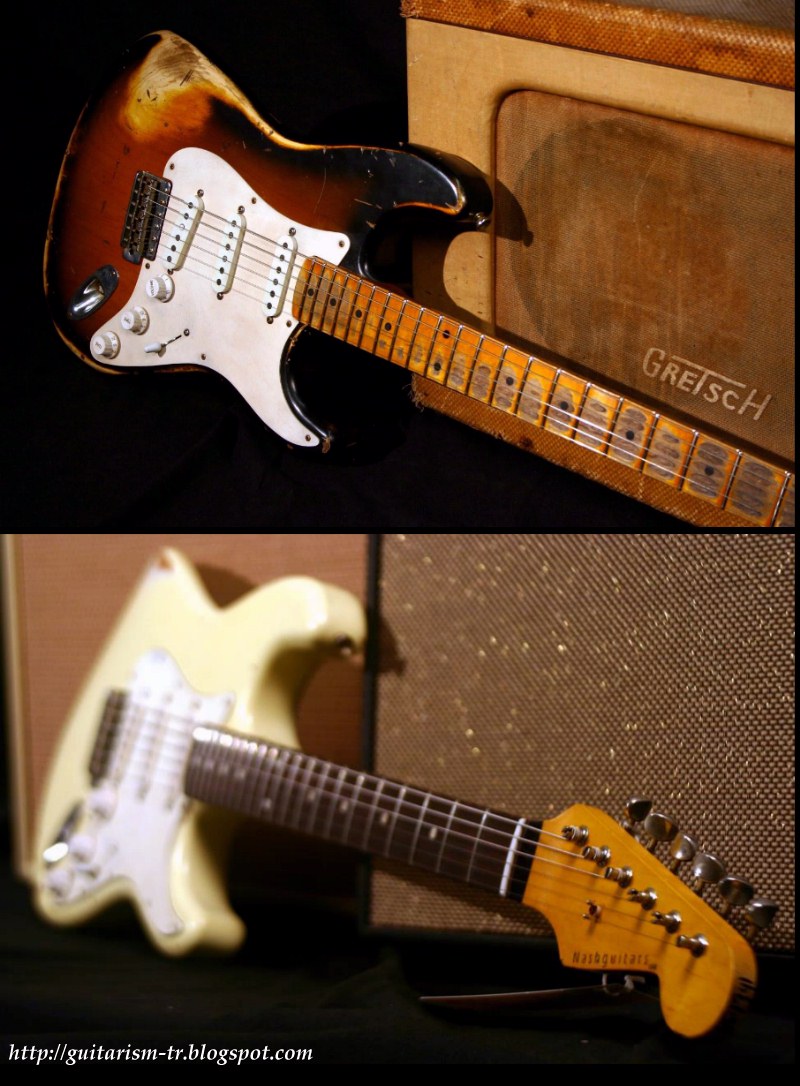
You have fine way of creating guitar concept, there is absolute care about details. How about the tremolos and their sustain blocks which i personally believe that they are very important on guitars sound and resonance? Do you prefer tremolos with pure steel blocks or brass ones?
The tremolos use standard steel blocks. I find that though other materials like brass or titanium have their place, they sound a bit less traditional. I think it is best to keep things simple.
There is undeniable increasing interest on reliced guitars recent years. Thats why there are some other relic strat/tele builders, Fender Custom Shop releases many relic guitars and Fender releases Mexican made “Road Worn” models. Whats your opinion about why is that? Why do people love those very dirty looking instruments?
I cannot speak for other makers of aged guitars, but the feedback we get is that people like the feel of the guitars as they are like an old worn-in boot of pair of jeans. It feels like you have owned and played the guitar for decades. The fact that there is less paint and the guitars resonate better makes them feel more alive and organic along with a better sound. The look and vibe of the guitars is secondary to the sound and feel. It is nice to have a guitar that you do not have to worry about scratching!
How many guitars do you make in every month?
About 90

How is your import/export situations? In how many countries can your guitars be bought?
We have dealers in 18 countries at this point but are adding more as time goes. We have more dealers in the US then anywhere else.
What is the limit of success to you? Are you satisfied about the level of the Nash Guitars?
I am very happy with the success we have. We could probably increase our business some, but now I have my hand on every guitar built and I would not want to lose that.





Do you have endorsers? Can you tell me about your projects about endorsements?
We do no formal endorsements as I think it is bad to use other peoples fame to make our guitars attractive to people. There are hundreds of our guitars being used by professionals including most of the top 10 touring bands in the US.
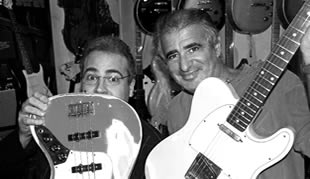
I’m at the end of our interview Bill. Whats your ending words?
Cheers! Come to https://www.nashguitars.com/ to see our guitars…
Nash Guitars Website | Twitter | Instagram
About Professor Guitarism:
Fan of electric guitar, metal, rock, progressive rock, blues, fusion jazz and classical music, Star Wars & Lord of the Rings (books), The Alien, Marillion, Iron Maiden, Dream Theater, Frank Zappa etc.
Columnist since 2005. Published many interviews made with Seymour W. Duncan, Steve Blucher, Lindy Fralin, Yuriy Shiskov, Steve Morse, Guthrie Govan, Bill Nash of Nash Guitars, Joe Satriani, Dave Weiner, Tony MacAlpine, Alex Skolnick, Dream Theater, Ian Anderson, Tim Mills etc.
Fields of interest: Once had a humble custom shop but now only medium to advanced level electric guitar modifications at home, electric guitar pickup modifications and sometimes even winding them, trying to play guitars never done before and, naturally, achieving more and more guitars.

